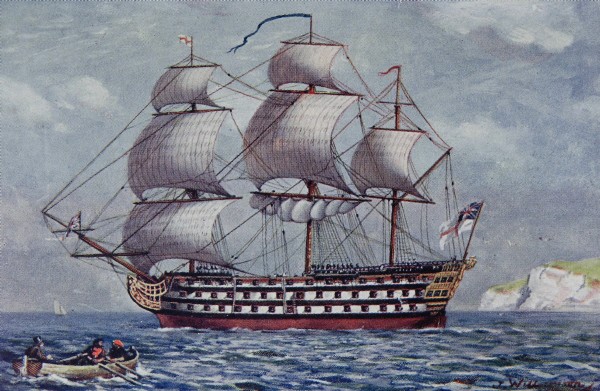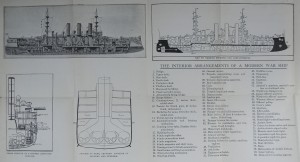7
The Royal Navy

LINE OF BATTLESHIP OF NELSON'S DAY
H.M.S. VICTORY
THE invasion of
England by the Romans, Saxons and Danes was only made possible by the
non-existence of a fleet. The great Alfred remedied this by collecting a fleet
and keeping it in a thoroughly efficient condition; later, after a period of
immunity from further invasion the fleet was neglected, and the opportunity
which came to the Conqueror again made it apparent that it was to the Navy that
England must look for her first line of defence.
In the reign of
John the Navy once more became thoroughly efficient; then followed the usual
reaction and indifference. Edward III. realized the importance of a powerful
fleet, but in a few years it again fell off, the result being that the French
were able to ravage Portsmouth and Winchester in 1372.
By Henry V.'s time, however, these attacks had been
effectually checked, and the birth of an established Mercantile Marine and of
that Empire may be said to have commenced with the Elizabethan Navigators.
The Spanish wars and the attempted invasion of the
Great Armada in the latter part of the sixteenth century, the final struggle
with the Dutch in 1692, and the battle of Barfleur (which put an end to the
plans of the French King) practically ended for the time any serious
consideration on the part of any foreign power of being able to force through
the line of the British fleet.
A century later,
however, the strength of the Navy declined once more, with the result that the
American colonies were lost. Then once again the vital necessity of
re-organization and development became apparent, and the modern British Navy
came into being, under the glorious guidance of Hawke, Rodney, Howe and Nelson.
The greatest
change, however, in the Royal Navy came in 1832 with the introduction of steam
power, which in that year was fitted to H.M.S. Salamander
(a paddle steamer). In 1843 a screw propeller was fitted to H.M.S. Rattler, the immediate success of which,
with regard to vessels of war, made its future universal adoption a certainty.
It was not, however, until 1848 that steam was applied to the class of warships
known as battleships, and then only as an auxiliary to full sailing rig. In
1856 the first iron-built war vessels were constructed, and in 1860 was built
(in consequence of the success in France of La
Gloire, an armoured vessel of great power and stability), the first
armour-clad iron vessel, H.M.S. Warrior.
The earliest armour
for men-of-war was made of wrought iron, but with the invention of hardened
steel shot, a steel-faced plate, backed with a softer metal, became necessary.
This in turn gave way to nickel steel or other forms of specially hardened
metal which obviated the defects of the compound metal armour formerly in use.
The control and
management of the Royal Navy is vested in the Lords of the Admiralty. The First
Lord, who is a civilian, is responsible to the Sovereign and Parliament for all
the business of the Admiralty. The First, Second and Junior Naval Lords are
responsible for the personnel of the Navy and the movements and the condition
of the fleet, the Third Lord (or "controller") for the Material, the
Civil Lord and the Parliamentary Secretary for the Finance, the permanent
Secretary being in charge of the Secretariat under the First Lord.
There are five
Royal Dockyards existing in England for the building, equipment and repair of
"Men-of-War." These are at Portsmouth, Chatham, Plymouth, Pembroke
and Sheerness; also twelve smaller dockyards or Depots, one being located in
Ireland, and the other more important ones at Malta, Sydney, Bermuda, the Cape
of Good Hope, Gibraltar and Hong Kong.
A battleship takes
from two to three years to build, and costs from £80,000 to £1,000,000 — a
cruiser takes from one to two years, at a cost of from £160,000 to £400,000, or
more. This is an increase of a very large percentage as compared with Nelson's
day, when a Line-of-Battle-Ship was floated for about £70,000, and a small
frigate for £12,600.
In former days the
largest ships were called Line-of-Battle-Ships; they were built of wood and
were classed as first, second and third-raters, according to the weight and
number of guns carried. Below this class ships were ranked as Frigates, Sloops
and Corvettes.
At the present day
the ships of the Royal Navy may be separated into two broad classes at least,
with regard to efficiency and invulnerability, namely, "Armoured" and
"Unarmoured," Armoured ships being those whose sides and guns are
protected by vertical plates of armour. These ships are classed as
"Battleships," and sometimes as "Armoured Cruisers."
Unarmoured vessels are those that are without protective armour, and include
Torpedo Boats, Destroyers, Gunboats, and other auxiliary craft.
The three main
divisions are First-Class, Second-Class and Third-Class Battleships — all of
which, of course, are armoured vessels varying in efficiency according to size,
number of guns, weight of armour and age.
Cruisers, whether
heavily armoured, or, as is more usual, only partially so, are classed as
First, Second and Third-Class Cruisers, according to their size, speed and age.
Destroyers properly
rank next in importance, as being not only of very high speed, but powerful
craft of high efficiency, well qualified to run down the torpedo craft of an
enemy's fleet, to perform scout duty, etc. Destroyers are unarmoured, and
carry only the lightest guns, but are usually fitted with two or more torpedo
tubes. Their steel plating is of the thinnest possible description, and they
have proved to be very "risky" craft to navigate and control.
The Government have
now under construction a new class of Destroyers called "Scouts."
These are more substantially built than the Destroyers, and are to act chiefly
as fast Cruisers, to obtain information of the whereabouts of an enemy, and to
carry dispatches and orders — in short, to perform the same kind of services at
sea as the cavalry perform on land. A former type of vessels designed for this
object — viz., the Torpedo Gunboat — was not successful, and the vessels are
now used chiefly for fishery protection duties.
Torpedo Boats and
Torpedo Gunboats are classed as of small fighting power under all conditions,
being for the most part only of value when an especially invulnerable point has
been left open to attack. The smaller Gunboats, while mounting rather heavier
guns than Torpedo Boats, or even than those of the Destroyer Class, are perhaps
more efficient than either of the other two classes, and, being of light draft,
are especially valuable for river or harbour work, or in bombarding the coast
from points of vantage where the waters may be too shallow for vessels mounting
heavier guns.
The Submarine is a
development in naval engines of war, which came to the front at the latter end
of the nineteenth century. The earliest application of these miniature craft,
which are propelled beneath the sur face of the water, to practical purposes
was made by the United States and France. The first submarines to be
constructed in Great Britain were five of the Holland type (called after the
American inventor).
Other auxiliary
craft are classed as Depôt or Supply Ships, Hospital Ships, Training Ships,
Dispatch Vessels, Store Ships, Troop Ships, Surveying Ships, Coast Guard
Cruisers, Sailing Cutters, Tugs, etc., and last (but not, it is to be hoped, by
any means least as regards value in warfare) "Merchant Cruisers,"
which include the largest and fastest of the great "Liners" built in
recent years by the leading Steamship Companies, and of whose efficiency there
can be no doubt (in consideration of their high speed and great coal-carrying
capacity, coupled with their great size and strength, which enable them to
mount guns).
Much discussion has
taken place during the last few years as to the efficiency of the new tubular
boilers of the "Belleville" type, fitted to a large majority of our
latest ships. The old form of steam generator — called the Scotch or locomotive
boiler — has been in use for warships ever since the introduction of steam
power, and the principle of the construction is that the flames are carried
through tubes which pierce the boiler with holes, as opposed to the water-tubes
running through the furnace. Experiments have been in progress some time and an
interim Report, issued by the Committee appointed to investigate the matter,
has been issued. This apparently condemns the "Belleville" type of
water-tube boilers as being wasteful and dangerous. It appears, however, that
other varieties of water-tube boilers will be adopted and not a return made to
the older Scotch pattern; as the chief advantage claimed by the former type is
in being able to get up steam quicker, owing to the larger heating surface.
Without attempting to express an opinion where experts disagree, it may be
mentioned that when the stokers have got used to the boilers, much good work
has been got out of them, notably in the long voyages of the Powerful and Terrible.
 [CLICK ON THE IMAGE ABOVE TO SEE A FULL RENDERING OF THE
INTERIOR ARRANGEMENTS OF A MODERN WARSHIP CHART]
[CLICK ON THE IMAGE ABOVE TO SEE A FULL RENDERING OF THE
INTERIOR ARRANGEMENTS OF A MODERN WARSHIP CHART]
For List of Ships
in the R.N. see Part II.
|

